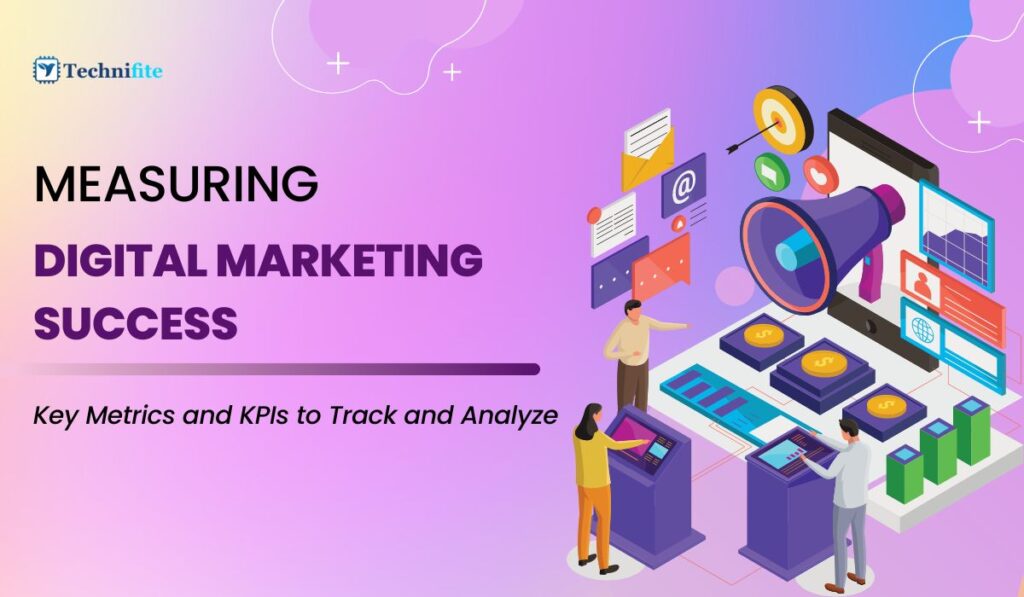Measuring Digital Marketing Success: In the dynamic landscape of digital marketing, success is not just about launching campaigns and hoping for the best. It’s about carefully monitoring and analyzing your efforts to determine what’s working and what’s not. To do this effectively, you must rely on a set of Key Performance Indicators (KPIs) and metrics that provide valuable insights into your digital marketing strategies. In this blog, we’ll delve into the world of digital marketing metrics and explore the key indicators that can help you measure your success.
The Importance of Measuring Digital Marketing Success
Before diving into the metrics themselves, it’s essential to understand why measuring digital marketing success is crucial. There are several reasons:
1. Data-Driven Decision Making: Measuring metrics allows you to make informed decisions based on concrete data rather than gut feelings. This leads to more effective strategies and resource allocation.
2. Optimization: Regularly tracking KPIs enables you to identify underperforming areas and optimize your campaigns for better results. This iterative process is key to long-term success.
3. Accountability: Measuring success provides a clear picture of the return on investment (ROI) for your marketing efforts, making it easier to justify budgets and resources to stakeholders.
4. Competitive Advantage: Understanding your performance relative to competitors helps you identify opportunities and stay ahead in the digital marketing landscape.
Key Metrics and KPIs to Track
Now, let’s explore some of the most important digital marketing metrics and KPIs you should be tracking:
1. Website Traffic
a. Website Traffic Volume: The number of visitors your website receives is a fundamental metric. Tools like Google Analytics can help you track this metric and segment it by source (organic, paid, social, etc.).
b. Bounce Rate: Bounce rate measures the percentage of visitors who leave your website after viewing only one page. A high bounce rate may indicate issues with your landing pages or content quality.
2. Conversion Rates
a. Conversion Rate: This KPI tracks the percentage of visitors who take a desired action, such as purchasing, signing up for a newsletter, or filling out a contact form. It’s a critical metric for assessing the effectiveness of your marketing funnel.
b. Click-Through Rate (CTR): CTR measures the percentage of people who click on a specific link, such as an ad or email. It’s commonly used for assessing the performance of digital advertising campaigns.
3. Customer Acquisition Cost (CAC)
CAC is the cost associated with acquiring a new customer. To calculate CAC, divide your total marketing expenses by the number of new customers acquired in a specific period. Lowering CAC while maintaining or increasing customer quality is a sign of efficient marketing.
4. Return on Investment (ROI)
ROI measures the profitability of your digital marketing campaigns. It’s calculated by subtracting your marketing costs from the revenue generated by those campaigns and then dividing the result by your marketing costs. A positive ROI indicates that your campaigns are profitable.
5. Customer Lifetime Value (CLV)
CLV represents the total revenue a customer is expected to generate throughout their relationship with your business. This metric is essential for understanding the long-term impact of your marketing efforts.
6. Social Media Engagement
For businesses active on social media platforms, tracking engagement metrics like likes, shares, comments, and followers can provide insights into the effectiveness of your social media strategies and content.
7. Email Marketing Metrics
a. Open Rate: The percentage of recipients who open your marketing emails. A higher open rate typically indicates a well-crafted subject line and relevant content.
b. Click-Through Rate (Email CTR): Similar to CTR for ads, this metric measures the percentage of email recipients who click on a link within your email.
8. SEO Metrics
a. Organic Search Traffic: The number of visitors coming to your website from search engines. Improving this metric often involves optimizing your website for search engines.
b. Keyword Rankings: Monitoring the ranking of your target keywords on search engine results pages (SERPs) can help you gauge the effectiveness of your SEO efforts.
9. Customer Satisfaction and Feedback
Collecting customer feedback through surveys or reviews can provide valuable insights into their experience with your brand. High satisfaction levels can lead to increased customer loyalty and positive word-of-mouth marketing.
The Power of Data Integration
Consider integrating data from various sources and platforms to get a comprehensive view of your digital marketing efforts. Tools like marketing automation software and customer relationship management (CRM) systems can help streamline this process, allowing you to analyze the data holistically.
Conclusion
Measuring digital marketing success is not just about tracking numbers; it’s about interpreting those numbers to make informed decisions and drive continuous improvement. The metrics and KPIs mentioned here provide a solid foundation for assessing the effectiveness of your digital marketing strategies. Remember that the digital landscape is constantly evolving, so adaptability and a willingness to experiment with new metrics are essential for long-term success in digital marketing.
Frequently Asked Questions
What is the most important digital marketing metric to track?
There isn’t a single “most important” metric, as it depends on your specific goals. However, conversion rate and return on investment (ROI) are often considered crucial because they directly tie marketing efforts to business outcomes.
How can I improve my website’s conversion rate?
To improve your conversion rate, you can work on optimizing your website’s user experience, refining your call-to-action (CTA) strategies, and conducting A/B testing to identify what resonates best with your audience.
How can I reduce customer acquisition costs (CAC)?
Reducing CAC involves optimizing your marketing channels, targeting the right audience segments, and improving the efficiency of your advertising campaigns. You can also explore referral programs and customer retention strategies to maximize the lifetime value of customers.
What’s the ideal email open rate and click-through rate (CTR)?
Ideal email open rates and CTRs can vary by industry, but as a general guideline, a 20-30% open rate and a 2-5% CTR are considered decent benchmarks. However, it’s essential to benchmark your performance against industry standards and strive for continuous improvement.
How do I measure customer lifetime value (CLV)?
To calculate CLV, you need to track the total revenue generated by a customer over their entire relationship with your business. This involves considering repeat purchases, referrals, and the average customer engagement duration with your brand.
What tools can I use to track these metrics?
Various tools are available for tracking digital marketing metrics, including Google Analytics, Adobe Analytics, HubSpot, and many others. The choice of tools often depends on your specific needs and budget.


